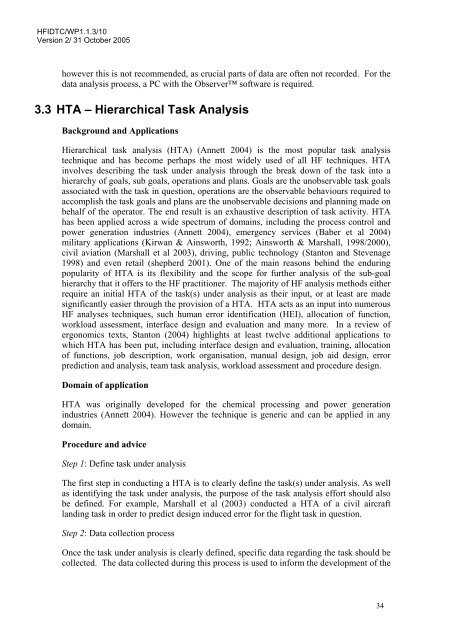A Review of the Event Analysis of Systemic Teamwork Methodology
A Review of the Event Analysis of Systemic Teamwork Methodology
A Review of the Event Analysis of Systemic Teamwork Methodology
- No tags were found...
Create successful ePaper yourself
Turn your PDF publications into a flip-book with our unique Google optimized e-Paper software.
HFIDTC/WP1.1.3/10<br />
Version 2/ 31 October 2005<br />
however this is not recommended, as crucial parts <strong>of</strong> data are <strong>of</strong>ten not recorded. For <strong>the</strong><br />
data analysis process, a PC with <strong>the</strong> Observer s<strong>of</strong>tware is required.<br />
3.3 HTA – Hierarchical Task <strong>Analysis</strong><br />
Background and Applications<br />
Hierarchical task analysis (HTA) (Annett 2004) is <strong>the</strong> most popular task analysis<br />
technique and has become perhaps <strong>the</strong> most widely used <strong>of</strong> all HF techniques. HTA<br />
involves describing <strong>the</strong> task under analysis through <strong>the</strong> break down <strong>of</strong> <strong>the</strong> task into a<br />
hierarchy <strong>of</strong> goals, sub goals, operations and plans. Goals are <strong>the</strong> unobservable task goals<br />
associated with <strong>the</strong> task in question, operations are <strong>the</strong> observable behaviours required to<br />
accomplish <strong>the</strong> task goals and plans are <strong>the</strong> unobservable decisions and planning made on<br />
behalf <strong>of</strong> <strong>the</strong> operator. The end result is an exhaustive description <strong>of</strong> task activity. HTA<br />
has been applied across a wide spectrum <strong>of</strong> domains, including <strong>the</strong> process control and<br />
power generation industries (Annett 2004), emergency services (Baber et al 2004)<br />
military applications (Kirwan & Ainsworth, 1992; Ainsworth & Marshall, 1998/2000),<br />
civil aviation (Marshall et al 2003), driving, public technology (Stanton and Stevenage<br />
1998) and even retail (shepherd 2001). One <strong>of</strong> <strong>the</strong> main reasons behind <strong>the</strong> enduring<br />
popularity <strong>of</strong> HTA is its flexibility and <strong>the</strong> scope for fur<strong>the</strong>r analysis <strong>of</strong> <strong>the</strong> sub-goal<br />
hierarchy that it <strong>of</strong>fers to <strong>the</strong> HF practitioner. The majority <strong>of</strong> HF analysis methods ei<strong>the</strong>r<br />
require an initial HTA <strong>of</strong> <strong>the</strong> task(s) under analysis as <strong>the</strong>ir input, or at least are made<br />
significantly easier through <strong>the</strong> provision <strong>of</strong> a HTA. HTA acts as an input into numerous<br />
HF analyses techniques, such human error identification (HEI), allocation <strong>of</strong> function,<br />
workload assessment, interface design and evaluation and many more. In a review <strong>of</strong><br />
ergonomics texts, Stanton (2004) highlights at least twelve additional applications to<br />
which HTA has been put, including interface design and evaluation, training, allocation<br />
<strong>of</strong> functions, job description, work organisation, manual design, job aid design, error<br />
prediction and analysis, team task analysis, workload assessment and procedure design.<br />
Domain <strong>of</strong> application<br />
HTA was originally developed for <strong>the</strong> chemical processing and power generation<br />
industries (Annett 2004). However <strong>the</strong> technique is generic and can be applied in any<br />
domain.<br />
Procedure and advice<br />
Step 1: Define task under analysis<br />
The first step in conducting a HTA is to clearly define <strong>the</strong> task(s) under analysis. As well<br />
as identifying <strong>the</strong> task under analysis, <strong>the</strong> purpose <strong>of</strong> <strong>the</strong> task analysis effort should also<br />
be defined. For example, Marshall et al (2003) conducted a HTA <strong>of</strong> a civil aircraft<br />
landing task in order to predict design induced error for <strong>the</strong> flight task in question.<br />
Step 2: Data collection process<br />
Once <strong>the</strong> task under analysis is clearly defined, specific data regarding <strong>the</strong> task should be<br />
collected. The data collected during this process is used to inform <strong>the</strong> development <strong>of</strong> <strong>the</strong><br />
34
















